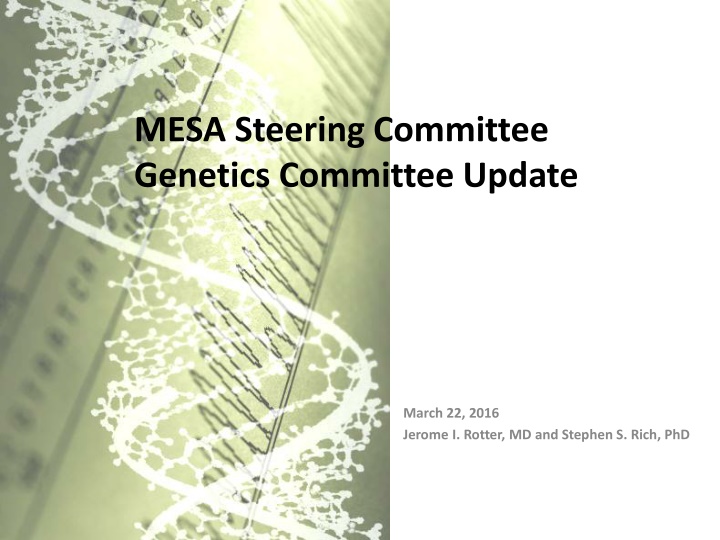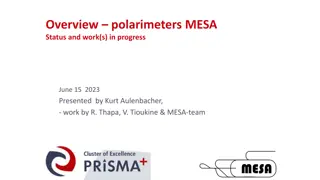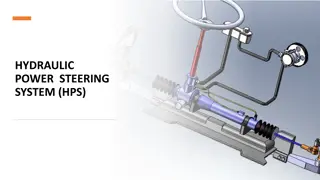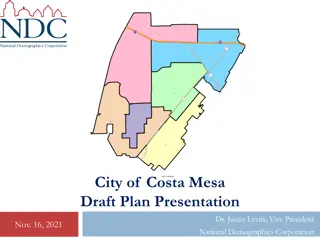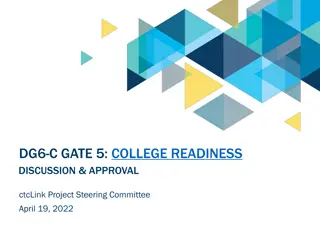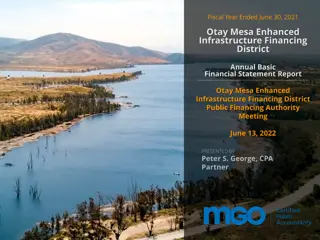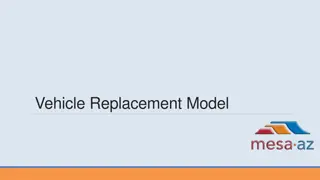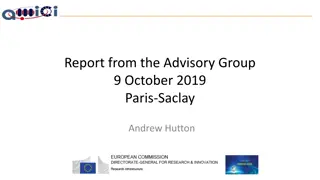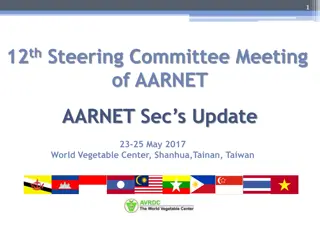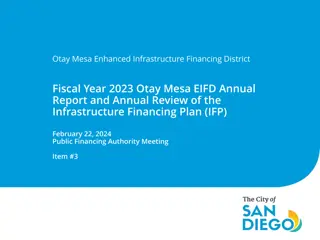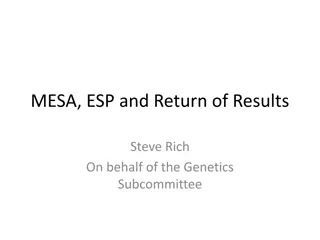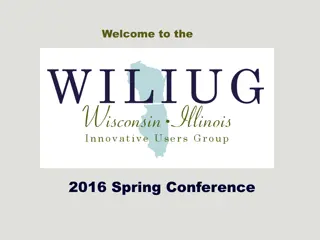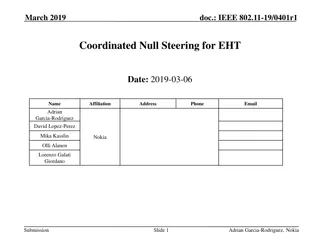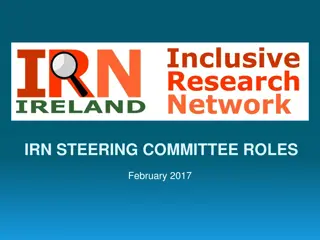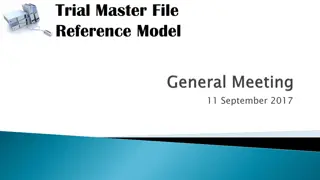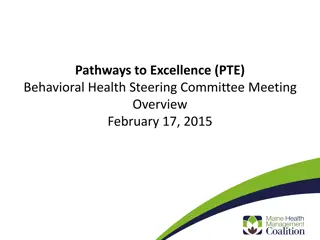MESA Steering Committee
The MESA Genetics Committee provides an overview of genetics updates, dataset availability, and progress on proposals and manuscripts. The post also highlights the Return of Results project aimed at confirming and returning actionable information to MESA participants.
Download Presentation

Please find below an Image/Link to download the presentation.
The content on the website is provided AS IS for your information and personal use only. It may not be sold, licensed, or shared on other websites without obtaining consent from the author.If you encounter any issues during the download, it is possible that the publisher has removed the file from their server.
You are allowed to download the files provided on this website for personal or commercial use, subject to the condition that they are used lawfully. All files are the property of their respective owners.
The content on the website is provided AS IS for your information and personal use only. It may not be sold, licensed, or shared on other websites without obtaining consent from the author.
E N D
Presentation Transcript
MESA Steering Committee Genetics Committee Update March 22, 2016 Jerome I. Rotter, MD and Stephen S. Rich, PhD
MESA Genetics Overview Update on Genetics P&P Recognition of the Committee members Progress to date Return of Results NHLBI TOPMed program Overview and Structure Manuscript and grant opportunities Additional omics interest Analytic Commons Description and Rationale MESA as a member of the Commons Analytic Commons MESA Genetics Committee, tonight at 7:30pm
Genetics Dataset Availability Available w/MESA ID from CC Available w/SHARe ID from CC Available w/SHARe ID from dbGaP Genetic dataset Affy 6.0 No Yes Yes Candidate Gene 1&2 Yes No No CARe IBC iSelect Yes Yes Yes 96 SNP Yes Yes No Metabochip Yes No No Exome Chip Yes Yes Yes Exome Sequence Yes Yes Yes Epigenomics methylation Yes No No Epigenomics expression Yes No No SHARe Principal Components Yes Yes No 1000 G Imputation No Yes No Phenotype Updates Yes Yes Yes Whole Genome Sequence In progress
MESA Genetics P&P Continued outstanding leadership and work Wendy Post (Chair), Xiaohui Li, Nancy Jenny, Ani Manichaikul, Jim Pankow, Christina Wassel, Lekki Frazier-Wood, Steve Rich (as needed) Thanks to Xiuqing Guo who has recently stepped down from the committee. Review of MESA-specific and consortia manuscripts (proposals and pen-drafts) Manuscript proposals Manuscript submissions Manuscript acceptance
MESA Genetics P&P Summary All SHARe Proposals approved Pen Draft Pending (Proposals approved; pen draft not yet approved) 478 354 283 213 Withdrawn 11 2 Pen Draft approved 184 139 Published 127 96 Pen Draft approved; not yet published 58 44 Pen Drafts not published Pending Pen Draft 0-3 months 24 16 3-6 months 14 18 6-9 months 11 6 9-12 months 25 9 12+ months 209 9
MESA Return of Results Aim: confirm and return actionable IFs to qualified MESA participants Project status: Completed Protocol drafted MOP drafted Field Center Script Specific questionnaires Variant annotation Secured testing in CLIA lab Failed contact letter Initial Decline letter To Do o Finalizing protocol and MOP o Create genetic contact script o Develop result letter o Create test kits source
NHLBI TOPMed Project Initiated in late 2014 to develop deep omics datasets (genomics, metabolomics, proteomics, lipidomics/inflammatory mediators) in NHLBI cohorts, focused on heart, lung, and blood diseases Initial (Phase 1) cohorts were chosen through an RFI (describing cohort characteristics and capabilities) and an RFA for whole genome sequencing (WGS) through R01 supplements.
Rationale for Whole Genomes Thousands of significant SNP-trait associations have been identified but the functional impact for most remain unknown In a 2009 analysis of GWAS index SNPs, a large proportion were intronic (45%) or intergenic (43%)* Relatively few trait-associated SNPs (<5%) are in coding regions Approximately 80% of trait-associated SNPs are in strong LD (r2 0.8) with a SNP with predicted functional, regulatory impact (e.g., DNase I site/footprint, ChIP-seq peak, in at least one cell line)** Many trait-associated SNPs identified in CHARGE have been convincingly annotated to lncRNAs *Hindorff et al, PNAS 106:9362, 2009. **Schaub et al, Genome Research 22:1748, 2012.
TOPMed Structure Participating projects (11 in Phase 1) Data Coordinating Center (University of Washington Cathy Laurie, Bruce Weir, Bruce Psaty) Informatics Resource Center (University of Michigan Goncalo Abecasis, Mike Boehnke) Sequencing Centers Broad Institute (Stacey Gabriel) University of Washington/Macrogen (Debbie Nickerson) New York Genome Center (Soren Germer, Mike Zody) Illumina Sequencing Service (Tonya McSherry, Karine Viaud)
TOPMed Projects Phase 1 Project Design Sample Size (1,142) 2,130 1,484 1,178 1,261 3,413 1,533 444 1,178 4,097 3,461 21,321 MA Families, San Antonio Genetic Epi of COPD Minority Children with Asthma Old Order Amish Large Pedigrees Case-Control Case only (AA-PR-MA) Large Pedigrees Asthma, African ancestry-Barbados High prevalence population Genetics of AF, PR interval Gen-Epi Asthma, Costa Rica Samoan Adiposity Study Cleveland Family Study Framingham Heart Study (EA) Jackson Heart Study (AA) Total Cases (Eur-Am) High prevalence, Hispanic High prevalence (obesity) Pedigrees, Sleep Measures Population-based, observational Population-based, observational
Data Access and Publication Each project (cohort) will receive its own variant calls as soon as these are available from the sequencing center Any sequence or phenotype data used in a publication will be submitted to dbGaP (if not already there, or by waiver from NHLBI) All WGS for initial Phase 1 projects is expected to be completed by February, 2016 Joint variant calling will be conducted at the University of Michigan and placed with harmonized phenotypes in a dbGaP Exchange Area to facilitate rapid analysis Prompt release to the broader community is expected
Data Access and Publication Data access and publication policy is intended to minimize obstacles to analysis and publication, ensure transparency, enable productivity tracking, and promote synergy across the TOPMed projects ~ 2 page online manuscript proposal form Rapid review with simultaneous cohort review as required Abstracts and manuscripts will be reviewed with a similar, rapid timeline Same basic process for other cohorts (e.g., MESA) and consortia (e.g., NHLBI ESP)
Vv Extending the Scope of TOPMed Expanding to additional cohorts & populations Targeted phenotypes (e.g., MI case-control) Increasing sample sizes in non-Caucasian populations Additional ethnicities (East Asian, South Asian) Additional phenotyping / phenotype access Biological samples: metabolomics, proteomics, lipidomics / inflammatory mediators, environmental measures Clinical phenotypes from EMR (lung conditions, heart failure, blood disorders)
Advantages & Contributions Experience with whole genome sequence data Integrating mutiple forms of omics data Existing consortium and working groups with harmonized phenotypes Developing models for Centralized and cloud computing Potential to analyze individual-level data without downloading Analytic methods that don t require individual-level data
TOPMed WGS Overview DNA samples sequence data Sequencing Center IRC Study Michigan study-specific call sets joint genotype call sets harmonized sequence data NCBI phenotypes phenotypes Study Coordinating Center dbGaP DCC UW SRA harmonized phenotypes phenotypes, genotypes, sequence data Working Group COPD Working Group asthma Study A analysis team Study B analysis team Working Group atherosclerosis Scientific Community etc... etc... Study-focused publications Cross study publications Personalized Medicine 16
Manuscript & Grant Opportunities Recall that each cohort (e.g., MESA) will receive VCFs/BAMs from dbGaP to be maintained in its own DCC Each cohort has many more phenotypes than the harmonized list (~150) for TOPMed Within TOPMed, there are Working Groups Within and across cohorts, there can be collaborations, and grant applications related to TOPMed and specific phenotypes A few R21 applications made already; R01s needed TOPMed provides support for transport of DNA to sequencing centers, and sequencing but not analysis
Analytic Commons CHARGE investigators, led by Eric Boerwinkle (ARIC), Bruce Psaty (CHS) and Adrienne Cupples (Framingham), recognized the need for a site that could provide support, curation, analytic framework, and security, for next-gen sequence data coupled with phenotypes Consideration of low cost of data storage, secure individual-level data, and ability to design and implement analytic tools Cloud-computing based resource for analysis & discovery Analytic Commons (where multiple cohorts can contribute data and analysis)
Implementation of the Analytic Commons Established relationship with DNANexus (www.DNAnexus.com), a company supporting a cloud- based platform, optimized for big data and computational biology Initiated with exome sequence data from CHARGE-S and ESP; extended to low-pass whole genome sequence data from CHARGE-S Initial activities (with significant support from DNAnexus technical staff) to establish work-flows, analysis pipelines, and developing/modifying existing analytic procedures
Opportunities NHLBI TOPMed will require protocols for analysis of the 100,000 whole genomes being generated Multiple possibilities from academia, NCBI, etc Analytic COMMONS currently the only working model With ARIC, CHS, Framingham working in the Commons, opportunity for MESA to join (with Jackson Heart Study)
